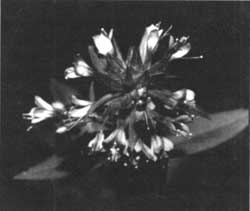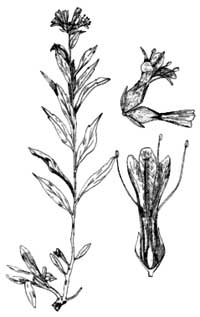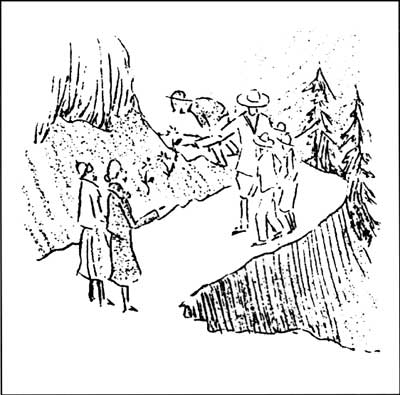The Rare Treasure of Mount Mazama Collomia
Mount Mazama Collomia (Collomia mazama) is a beautiful and rare member of the phlox family endemic to Crater Lake National Park and adjacent lands on the Rogue River and Winema national forests. It is a perennial species primarily restricted to the open woods and meadows of the lodgepole pine and true fir forest communities of southern Oregon’s Cascade Range. This species was discovered by the noted botanist F.V. Coville along Dutton Creek, just two air miles from Crater Lake, in 1896. Modern day explorers can still observe a healthy population of these plants at this site (called a type locality), though the species is considered threatened throughout its range. There are only 55 known populations, of which 12 (or 22 percent) occur within Crater Lake National Park.
 A Mount Mazama collomia in bloom. Photo by Casey Baldwin. |
C. mazama is one of eleven species in the genus Collomia found in western North America. It is herbaceous and perennial, ranging from 15 to 30 cm tall, with broadly lanceolate leaves having distinctive irregular teeth towards the apex. Flowers are borne in terminal, head-like cymes, and possess funnelform shaped corollas up to 1.5 cm broad; coloration is lilac, bright purple, deep blue, or violet. Adding to its beautiful appearance are the exerted stamens with powder blue anthers. The inflorescence is covered with glandular hairs that exude a slight skunky odor. Three small, black seeds are produced per capsule and are explosively dehiscent — where seeds have been observed to disperse up to half a meter. Flowering occurs from June through September.
Two other perennial, blue-flowered Collomia species occur at high elevations in Oregon. These are C. debilis var. debilis and C. larsenii. C. debilis can be distinguished from C. mazama by its larger flowers (1.5 to 3.5 cm) and sprawling habit. It is only found in central and northeastern Oregon. C. larsenii is also distinguished by its sprawling habit, and pinnately- or palmately-lobed leaves, as compared to the erect habit and toothed leaves of C. mazama. Collomia larsenii occurs in the Olympic Mountains and Cascade Range.
Collomia mazama predominately inhabits places at high elevation (4800 to 6300 feet), where it associates with mountain hemlock, red/noble fir, and lodgepole pine. Minor habitats include the mixed conifer forest, the interface of meadows with incense-cedar, and riparian areas. The largest C. mazama population found within Crater Lake National Park is located on the middle fork of Copeland Creek, near the Pacific Crest Trail. White fir (Abies concolor), Red noble fir (A. magnifica-procera), lodgepole pine (Pinus contorta), incense-cedar (Calocedrus decurrens), and mountain hemlock (Tsuga mertensiana) are present in the overstory, with thinleaf huckleberry (Vaccinium membranaceum), Crater Lake currant (Ribes erythrocarpum), and baldhip rose (Rosa gymnocarpa) in the understory. Other large populations of Mount Mazama collomia occur along lower Bybee Creek and southwest of Sphagnum Bog along Crater Creek, whereas smaller populations occur along the north and south forks of Copeland Creek, Sphagnum Bog, and upper Bybee Creek. The Dutton Creek population, along with those between Sphagnum Bog and the Pacific Crest Trail, occur where lodgepole pine, scattered red/noble fir, and mountain hemlock dominate the forest canopy. In these places grouse huckleberry (V. scoparium), two-colored lupine (Lupinus bicolor),meadow penstamon (Penstamon rydbergii), and long-stolon sedge (Carex pensylvanica)largely comprise the understory. The population at Thousand Springs is the smallest (less than 35 individuals) but the most unique in the park, occurring in the drier portion of a riparian zone with associated huckleberry and a sparse overstory of lodgepole pine and red/noble fir.
 Mount Mazama Collomia. Drawing by Charles F. Yocum, ca. 1951. |
Concern over the long-term viability of Mount Mazama collomia, as well as the lack of basic biological information, prompted a cooperative research effort. Personnel from the National Park Service, U.S. Forest Service, and the University of Idaho worked together in developing a comprehensive conservation strategy. At the same time, grants from Canon USA, Stillinger Botanical, and the Mazamas assisted me with gathering data on the plant’s genetic structure, reproductive biology, demography, and ecology. The most relevant findings are summarized in the following paragraphs.
A genetic analysis of 20 populations from Crater Lake National Park and surrounding national forest lands was conducted using starch gel electrophoresis. The overall genetic diversity turned out to be low, with only 2 of 22 loci exhibiting more than one allele. Most of the genetic variation is contained between populations (particularly the northern versus southern, with Red Blanket Creek being a rough dividing line). In all likelihood, the distinction is due to random genetic drift. This is probably due to small population sizes sometime in the past, a characteristic common to many species of rare plants. Populations within and immediately adjacent to Crater Lake National Park contain the highest levels of genetic diversity within the species and thus represent a valuable genetic resource.
Another study tracked demographics (birth, growth, death, and reproductive success) of eight C. mazama populations that occupy the range of habitats in which this species is typically found. Over 4,000 individuals were located, marked, and measured over a four year period. Research results indicate that a large number of seeds may be produced during a given year (up to 750 seeds per square meter) but the rates of germination and survival are extremely low. No more than ten percent of seeds will germinate the following year, with a mortality rate of 50 percent in each of the successive growing seasons. Seedling growth averages one centimeter per year, with flower and seed production beginning at a height of 5-10 cm, or at an estimated age of 7-12 years. Up to 50 percent of the plants flowering in a given season will not flower the following year, and approximately 10 percent of the population will be dormant for a full growing season. Additionally, predation by deer appears to play a significant role in the population dynamics of this species, with up to 45 percent of a population being eaten before setting seed. Taken together, these factors indicate that the rarity of this plant may be due to the combination of low survivorship, slow growth rates, and predation.
Restoration efforts
According to one survey, several C. mazama populations have been impacted by activities associated with the trail system in Crater Lake National Park. Both seedlings and vegetatively propagated clones are being evaluated so as to find the best way to restore these populations. Due to the relatively slow growth rate of seedlings, it was thought that the use of material propagated from mature plants would result in better reestablishment. Results from the propagation of seedlings and vegetative clones in a greenhouse environment showed that both grow at the same rate, flowering after reaching a height of 7 cm. Flowering is a function of plant height, whereas the growth rate seen in seedlings is the result of environmental conditions. Field trials were initiated in the latter part of 1997 to evaluate the establishment of seedlings and vegetative clones on compacted and non-compacted sites in both spring and fall plantings. The only observed difference so far is that spring plantings have a higher mortality rate due to predation by deer.
Efforts to restore Mount Mazama collomia within Crater Lake National Park are promising, yet this rare plant continues to face a variety of threats throughout its limited range. We can hope, however, that the research and conservation efforts made by scientists, land managers, and volunteers so far will continue making headway.Collomia mazama is a botanical treasure, one to be enjoyed now and by future generations.
Casey Baldwin is a doctoral candidate at the University of Idaho and the principal author of a conservation strategy for Mount Mazama collomia.

Drawing appeared in “The Community House,” Nature Notes from Crater Lake, 5:3 September 1932.

